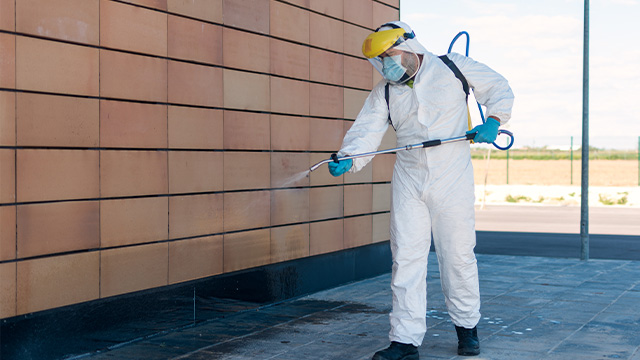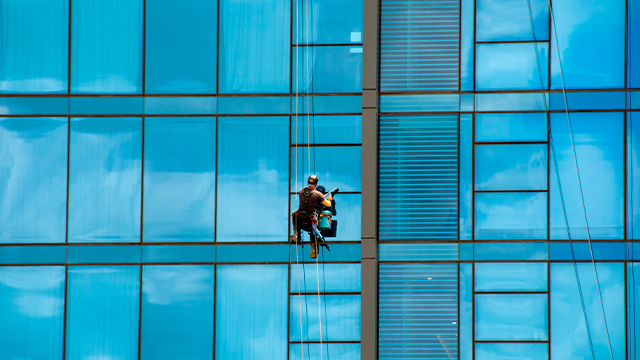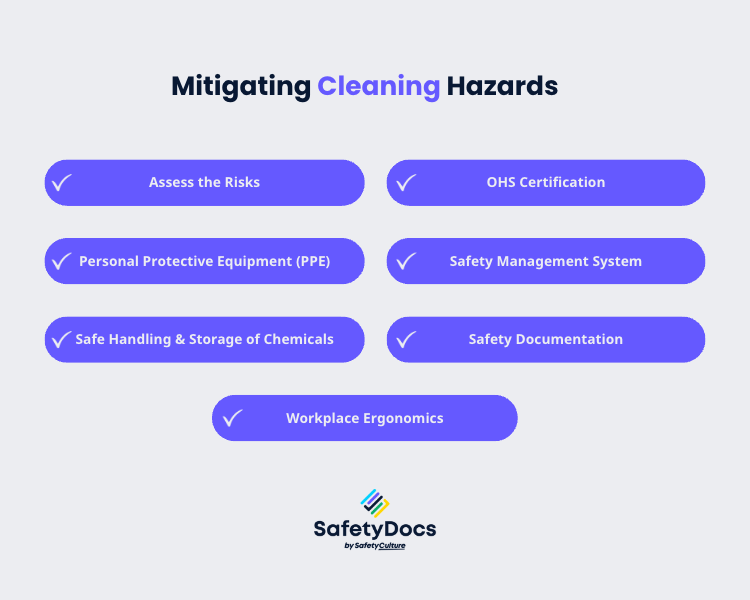The cleaning industry employs individuals in multiple capacities to maintain cleanliness and hygiene in different settings. This industry in Australia has three main categories — Residential, Commercial, and Industrial Cleaning. There are many niche services under these broad segments.
Like any other industry, the cleaning industry has inherent hazards. From exposure to hazardous chemicals to ergonomic strains, slips, trips, and falls, cleaning professionals face various occupational safety risks. This blog will explore the common hazards in the Australian cleaning industry and discuss effective mitigation strategies to reduce risks and ensure a safe workplace.
What is Meant by Cleaning?
Cleaning means eliminating dirt, dust, stains, and other contaminants from various surfaces, objects, and environments. This improves the overall appearance of the space and helps maintain a healthy and sanitary environment. Some common aspects of cleaning include:
- Surface Cleaning: This involves wiping, scrubbing, or washing surfaces like floors, countertops, walls, and windows using appropriate cleaning agents (detergents) and tools (sponges, brushes, mops, etc.).
- Deep Cleaning: This goes beyond regular surface cleaning and targets hard-to-reach areas, accumulated dirt, and stubborn stains.
- Disinfection: This focuses on killing or inactivating microorganisms that can cause infections or illnesses, using chemical agents to destroy harmful microorganisms on surfaces and objects.
- Deodorisation: This eliminates unpleasant odours caused by bacteria, mould, mildew, or other sources, using air fresheners, neutralisers, or specialised products that target the source of the smell.
- Waste Management: This includes the collection, segregation, and disposal of waste materials, such as trash, recyclables, and hazardous substances, in a safe and environmentally-friendly manner.

Who Works in the Cleaning Industry?
The cleaning industry is a dynamic field that encompasses many jobs and roles. The industry relies on a diverse workforce, from cleaners to specialised technicians, to maintain cleanliness and hygiene in various settings.
The industry employs approximately 151,300 people, and the total number of employees in the labour force is expected to grow even more in the years to come. Here are the different professionals who contribute to the cleaning industry:
- Cleaners: Cleaners are responsible for cleaning and maintaining the cleanliness of residential and commercial properties. They are proficient at completing various chores, including dusting, vacuuming, mopping, and sanitising bathrooms and kitchens.
- Janitors: Janitors play a pivotal role in upholding the sanitary standards of public spaces like hospitals, schools, and government buildings. From maintaining gleaming floors to keeping restrooms pristine, these professionals ensure that these facilities are tidy, welcoming, and conducive to people's health.
- Housekeepers: Housekeepers are responsible for cleaning and maintaining the cleanliness of private residences. They perform tasks such as dusting, vacuuming, and cleaning bathrooms and kitchens.
- Carpet Cleaners: Carpet cleaners are responsible for cleaning and maintaining the cleanliness of carpets in residential and commercial properties. They use specialised equipment and cleaning solutions to remove dirt and stains from carpets.
- Window Cleaners: Window cleaners are responsible for cleaning and maintaining the cleanliness of windows in residential and commercial properties. They use specialised equipment and cleaning solutions to remove dirt and grime from windows.
- Industrial Cleaners: Industrial cleaners are responsible for cleaning and maintaining the cleanliness of industrial facilities, such as factories and warehouses. They perform tasks such as cleaning floors, walls, and machinery.
- Environmental Service Technicians: Environmental service technicians work in healthcare facilities, including hospitals and clinics. They are responsible for maintaining a clean and sterile environment to prevent the spread of infections. They follow strict protocols and use specialised cleaning agents to ensure healthcare facility hygiene.
Importance of Cleaning Safety
The cleaning industry is vital in maintaining a healthy and sanitary environment in various settings, such as offices, hospitals, schools, and homes. The Household Cleaners market in Australia is projected to grow by 3.86% (2023-2028), resulting in a market volume of US$0.48bn in 2028. This growth means more cleaning professionals entering the industry, and protecting them from potential health and safety risks is paramount.
It is crucial to prioritise safety practices in this industry to ensure the well-being of both cleaning professionals and the people using the cleaned spaces. Here are some reasons why safety is essential in the cleaning industry:
Protection of Cleaning Staff
Cleaning professionals are frequently subject to various risks, from hazardous chemicals and biological waste to physical hazards such as slips, trips, and falls. Prioritising safety helps protect these workers from injury, illness, or other adverse effects on their health.
Prevention of Cross-Contamination
Proper safety measures help prevent cross-contamination, which can occur when harmful bacteria, viruses, or allergens are unintentionally transferred from one area to another. Following safety guidelines such as using colour-coded cleaning equipment and proper waste disposal can minimise the risk of cross-contamination and maintain a healthier environment.
Proper Use of Cleaning Chemicals
It is essential to follow safety guidelines for storing, handling, and disposing of these chemicals to prevent exposure to harmful substances. Cleaning personnel must receive adequate training on using personal protective equipment (PPE) when they handle chemicals, which is essential for safeguarding their well-being.
Compliance with Regulations
Maintaining safety standards is paramount for cleaning companies to comply with local, state and federal occupational health and safety regulations. Failure to do so can lead to fines, penalties and legal repercussions. Prioritising managing health and safety in cleaning businesses can mitigate these consequences and enhance their reputation within the industry.
Increased Efficiency and Productivity
A safe work environment promotes increased efficiency and productivity among cleaning professionals. When workers feel protected and know their employer values their well-being, they are likelier to perform their tasks effectively and efficiently. This results in better quality cleaning services and happier clients.
Reduced Liability
By maintaining a safe work environment and following safety guidelines, cleaning companies can reduce the risk of accidents and injuries. This, in turn, reduces the potential for liability claims, lawsuits, and insurance premium increases.

Common Hazards
Let us detail the common hazards found in the cleaning industry to identify potential workplace safety concerns and develop effective mitigation strategies.
1. Chemical Hazards
Cleaning staff often use chemicals in cleaning products, such as detergents, disinfectants, and solvents. When mishandled, these chemicals can cause skin irritation, respiratory issues, and eye injuries. Sometimes, prolonged exposure to certain chemicals can lead to chronic health problems.
2. Biological Hazards
Cleaning professionals may encounter biological hazards like bacteria, viruses, fungi, and allergens. These can be present in various settings, including restrooms, kitchens, and healthcare facilities. Exposure to these contaminants can cause infections or allergic reactions.
3. Ergonomic Hazards
Repetitive motions, awkward postures, and heavy lifting are common ergonomic hazards in the cleaning industry. These factors can cause musculoskeletal disorders like back pain, carpal tunnel syndrome, and tendonitis. Prolonged standing or bending can also contribute to fatigue and discomfort.
4. Slips, Trips, and Falls
Wet or slippery surfaces, cluttered work areas, and poor lighting can increase the risk of slips, trips, and falls for cleaning professionals. These incidents can result in injuries, such as sprains, fractures, and even head trauma.
5. Electrical Hazards
Cleaning personnel might come across electrical risks while operating equipment, such as floor polishers or vacuum cleaners, and when working in proximity to power outlets and cords. Improper handling of electrical equipment or damaged cords can lead to electrocution or fires.
6. Noise Hazards
Some cleaning tasks involve using noisy equipment, such as pressure washers or floor polishers. Extended exposure to high noise levels can lead to hearing damage and contribute to increased stress and fatigue.
7. Psychological Hazards
The cleaning industry can be demanding, with tight deadlines, high expectations, and sometimes challenging working conditions. These factors can lead to psychological hazards, such as stress, burnout, and anxiety.
8. Confined Spaces
Confined spaces are another common hazard for cleaning staff, especially when combined with potentially harmful chemicals. The biggest issue with confined spaces is airflow (or its need). As such, the atmosphere in a confined space may be wildly different from the atmosphere outside. This includes things like hazardous materials, confined spaces, ventilation, and ergonomics
9. Mould
Mould is a common hazard in the cleaning industry and can cause respiratory complications and other health issues. Employers should require PPE and respirators for workers on a site that involves mould cleanup and ensure they wash their hands when done.

Mitigating Hazards
Effective hazard mitigation strategies are crucial to safeguard workers from potential health risks. Such methods are essential to ensure the safety of workers and reduce the likelihood of accidents. The following measures can significantly reduce the hazards associated with cleaning tasks:
Assess the Risks
Employers should assess the risks involved with cleaning and identify potential hazards. This can help them develop effective control measures to mitigate these hazards.
Personal Protective Equipment (PPE)
PPE acts as a barrier between the worker and the hazards, reducing the chances of direct exposure and minimising the risk of injuries or illnesses. This includes wearing gloves, masks, goggles, and protective clothing as necessary.
Safe Handling and Storage of Chemicals
Cleaning chemicals should be handled with care to prevent accidents and minimise exposure. Training workers in diluting, mixing, and applying cleaning agents is essential. Proper ventilation during cleaning work is necessary to avoid fumes buildup, and storage of chemicals should be in well-labelled containers far from incompatible substances.
Workplace Ergonomics
Ergonomics should be the primary consideration to mitigate the risk of musculoskeletal injuries. This includes adjustable equipment provision, proper lifting techniques, regular breaks from manual tasks, stretching exercises, and organising cleaning tasks to minimise repetitive movements and excessive physical strain.
OHS Certification
In Australia, there is no specific licensing requirement for cleaners or cleaning companies, and cleaning personnel are not mandated to possess any particular qualifications. However, obtaining relevant certifications from recognised bodies is an excellent way to demonstrate commitment to safety and compliance. This can include qualifications such as Certificate IV in Work Health and Safety or a Certificate III in Cleaning Operations (Commercial Cleaning). By obtaining these certifications, workers acquire the necessary knowledge of cleaning hazards and training on safe equipment and chemical use.
Safety Management System
One must have suitable cleaning methods, schedules, equipment, trained cleaners, and reliable communication to manage the task of cleaning effectively. It's this comprehensive approach that ensures cleaning is executed correctly and safely.
Safety Documentation
To ensure compliance with safety regulations, employers should have written safety procedures and ensure they are regularly updated. Keeping track of accidents and injuries is essential to identify potential hazards and necessary control measures. Proper documentation of all elements is crucial to create a comprehensive occupational health and safety (OHS) system.
Safety Docs Can Help Maintain Cleaning Safety
Your cleaning safety program should include adequate documentation, correct procedures, training, and support to ensure your cleaners know the hazards and how to mitigate them. SafetyDocs by SafetyCulture specialises in helping various industries develop a complete safety program with resources such as ready-to-use documents and template materials.
We can help you ensure cleaning safety with tools like risk assessments, job safety analyses, register forms, and more. With these documents, employers can effectively identify and mitigate the potential hazards that cleaners might encounter in their work environment.
Start by checking out the following documents:
- Integrated Management System for Cleaning
- Cleaners Safe Work Method Statements Pack
- Cleaners HSEQ Management System for New Zealand
- Cleaning Services Standard/Safe Operating Procedure (SOP)
Keeping your workers safe is critical to maintaining an efficient and successful business. With the right tools, you can ensure your cleaning staff are safe while performing their duties. Contact SafetyDocs today to get started!
Our team of experts is dedicated to providing accurate and informative content. Craig Cruickshank, our senior HSEQ advisor at SafetyDocs by SafetyCulture has reviewed this blog post to ensure the highest level of quality.
Learn more about Craig's work on LinkedIn for more industry insights.
Available for instant download and supplied in fully editable MS Word format for use in your business.
Please note that the above information is provided as a comment only and should not be relied on as professional, legal or financial advice.
Share This Article
